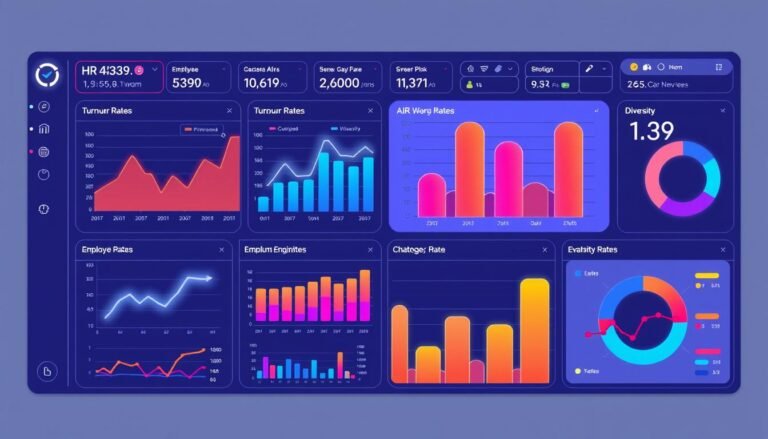Talent Pipelining and Succession Planning
Workforce planning is changing. Companies face skills gaps and talent shortages. Talent pipelining and succession planning are key to solving these problems. They help businesses grow their candidate pool and prepare for future leaders.
Identifying high-potential candidates is crucial. McKinsey found that top performers in complex fields are eight times more productive than average workers. This makes talent pipelining essential for business success. It’s about finding and nurturing the best talent before you need it.
Succession planning is closely tied to talent pipelining. It’s especially important in industries with high turnover, like tech and healthcare. Good succession plans help fill potential openings and boost worker loyalty. Over 90% of younger workers feel more engaged when their company has a clear succession plan.
These strategies are not just about filling roles. They’re about creating a culture of growth and development. This approach can lead to lower turnover and higher productivity. It’s a win-win for both employees and employers.
Key Takeaways
- Talent pipelining widens the candidate pool for future needs
- Succession planning is crucial for business continuity
- High performers are 8x more productive in complex fields
- Over 90% of young workers value clear succession plans
- These strategies can reduce turnover and increase engagement
- Talent pipelining can help eliminate bias in hiring
- Succession planning often involves 1-3 year notice periods for top roles
Understanding Talent Pipelining
Talent pipelining is key to a good Talent Acquisition Strategy. It’s about building relationships with potential candidates for future jobs. This helps companies stay ahead in the job market.
Definition and Importance
Talent pipelining means having a pool of ready candidates for future jobs. It’s a forward-thinking way to meet talent needs before they become urgent. With 77% of organizations facing a leadership gap, it’s crucial.
“Talent pipelining is not just about filling current vacancies; it’s about preparing for the future of your organization.”
Key Components of Talent Pipelining
Effective talent pipelining includes several important parts:
- Identifying future talent needs
- Building relationships with potential candidates
- Engaging passive candidates
- Creating a diverse talent pool
- Continuous assessment and nurturing of potential hires
These parts work together to build a strong Talent Acquisition Strategy. It supports long-term Organizational Talent Management goals.
| Benefits of Talent Pipelining | Impact |
|---|---|
| Reduced time-to-hire | Faster filling of critical positions |
| Improved quality of hires | Better fit for organizational culture |
| Cost-effectiveness | Lower recruitment costs over time |
| Enhanced employer brand | Increased attractiveness to top talent |
By using a strong talent pipelining strategy, organizations can tackle the 80% of CEOs worried about skill gaps. It’s a proactive approach that matches the 94% of employees who want to stay longer at companies that invest in their growth.
What is Succession Planning?
Succession planning is a strategic way to ensure Leadership Development and Succession Readiness in an organization. It finds and grows future leaders for key roles when current ones leave. This is key for keeping the business running smoothly and growing.
The Role of Succession Planning
Succession planning is essential for an organization’s future. It helps in a smooth leadership handover, reducing disruptions and keeping things stable. A good plan helps the organization stay healthy by:
- Building talent for future leadership roles
- Being ready for unexpected departures or retirements
- Helping the company adapt to change
- Keeping important knowledge and skills in the company
Benefits of Having a Succession Plan
Having a strong succession plan brings many benefits to organizations:
- Keeping employees happy and loyal
- Making the business more stable and trusted by stakeholders
- Lowering costs for hiring and training
- Boosting employee engagement and happiness at work
A survey showed that 90% of employees value learning and growth for job satisfaction. By focusing on Succession Readiness, companies can meet this need and secure their leadership future.
“Organizations that fail to plan or create a succession pipeline risk losing the confidence of stakeholders and investors from uncertainty and unfamiliarity.”
Despite the clear benefits, a global survey found that 53% of companies didn’t have a plan for CEO succession. This shows the need for more focus on Leadership Development and Succession Readiness across all industries.
The Relationship Between Talent Pipelining and Succession Planning
Organizational talent management is all about the connection between talent pipelining and succession planning. These strategies are key to a solid workforce plan. They make sure the right people are in the right spots at the right time.
How They Complement Each Other
Talent pipelining and succession planning work together to build a strong talent system. Talent pipelining brings in new talent, while succession planning grows leaders from within. This way, organizations always have skilled people ready to step up.
Companies that use both see big wins:
- 92% say promoting and planning for succession is key for managing talent.
- 78% of high-potential employees get special development chances.
- 81% of employees in strong talent pipelines feel more engaged.
By using both, companies meet today’s and tomorrow’s talent needs. Talent pipelines attract passive candidates, saving on recruitment costs. Succession planning prepares employees for leadership roles, keeping them loyal and ready for the future.
This combined strategy keeps organizations stable and fresh. It’s a winning formula for growth and success in today’s fast-paced business world.
Strategies for Effective Talent Pipelining
In today’s job market, having a strong Talent Acquisition Strategy is key. With 72% of CEOs worried about talent, finding and keeping top talent is vital. Building a strong candidate pool is essential.
Identifying Future Talent Needs
Forecasting your workforce is crucial. It helps match talent with business goals. You need to:
- Regularly analyze the market
- Compare yourself to competitors
- Check your team’s skills
Engaging with Potential Candidates
It’s important to connect with potential hires. Good strategies include:
- Hosting networking events
- Keeping in touch with passive candidates
- Using social media
CRM systems help keep in touch with candidates, even when you’re not hiring.
| Key Metrics | Description |
|---|---|
| Pipeline Velocity | How fast candidates move through stages |
| Conversion Rates | How many candidates accept offers |
| Diversity Ratios | How diverse your team is |
| Talent Scores | How good your candidates are |
By using these strategies and tracking these metrics, you can create a diverse, top-notch talent pipeline. This meets your current and future needs.
Building a Robust Succession Plan
A strong succession plan is key for leadership growth and getting ready for the future. It makes sure there are people ready to take on important jobs. This lowers risks and makes employees happier and more engaged.
Steps to Develop a Succession Plan
To make a good succession plan, follow these steps:
- Identify critical roles in the organization
- Assess required skills and competencies
- Spot high-potential employees
- Develop leadership training programs
- Implement mentorship and coaching initiatives
- Regularly review and update the plan
These steps help build a strong talent pipeline. They also ensure leadership keeps going. It’s important to grow diverse leaders to meet customer needs and spark new ideas.
Identifying Key Positions and Future Leaders
It’s crucial to spot key positions and future leaders. This includes:
- Conducting skill gap analyses
- Using assessments and feedback to identify leadership potential
- Implementing leadership development programs
- Creating individual development plans for high-potential employees
By focusing on these areas, organizations can make sure they have a solid group of candidates. These candidates are ready to take on important roles when needed.
| Succession Planning Benefits | Impact |
|---|---|
| Leadership Continuity | Ensures qualified individuals for critical roles |
| Risk Mitigation | Reduces disruptions from unexpected departures |
| Employee Engagement | Boosts morale through career growth opportunities |
| Organizational Reputation | Signals stability and preparedness for the future |
Tools and Technologies for Pipelining
In today’s job market, companies need strong tools to find the right talent. Modern software and data analytics help make the hiring process smoother. They also improve how companies manage their talent.
Software Solutions to Consider
Many new platforms are changing how we find talent:
- LinkedIn: With 433 million members, it’s a great place to find talent.
- Findly: Makes it easy to create profiles and engage with talent communities.
- Oracle HCM: Helps with planning for the future by using internal talent.
- SmashFly: Brings in 1000 new candidate leads every day.
- Beamery: Makes workflows automatic, treating candidates like valued customers.
Leveraging Data Analytics
Data insights are changing how we find talent:
| Tool | Function | Benefit |
|---|---|---|
| The Predictive Index | Candidate-position matching | Improves pipeline development |
| Archively | Information storage and sourcing | Streamlines candidate management |
| HireCanvas | College recruiting | Enhances student relationship management |
| TalentCircles | Candidate sorting and interviewing | Efficient pipeline management |
Using these tools, companies can greatly improve their talent management. The right mix of software and analytics leads to better hiring. It also means a stronger talent pipeline.
Skills and Competencies in Talent Management
Talent management is evolving quickly. Companies must focus on skills and competencies to stay competitive. The World Economic Forum says by 2025, machines might replace 85 million jobs. Yet, 97 million new roles could emerge, making strong High-Potential Identification and Leadership Development crucial.
Assessing Skills Gaps
To build a strong workforce, companies must first find skill gaps. This involves:
- Analyzing current skills
- Predicting future needs
- Comparing the two to find gaps
By 2025, about 50% of global workers will need to reskill. Identifying these gaps is key. Companies that ignore these gaps risk being left behind.
Training and Development Opportunities
After finding gaps, the next step is to offer training and development. This can include:
- Mentoring programs
- Job rotations
- Leadership workshops
Only 34% of employees get skill development chances. This gap is a chance for companies to shine. Investing in Leadership Development can make companies more attractive to employees by 98%.
Effective talent management focuses on both hard and soft skills. By regularly checking for skills gaps and offering specific training, companies can get ready for future challenges. This strategy not only helps in spotting High-Potential Employees but also boosts the entire workforce. It ensures success in a fast-changing business world.
Challenges in Talent Pipelining
Talent pipelining is key to any good talent strategy. But, it faces its own set of problems. Finding top talent is hard because their skills might not be obvious at first. This shows the importance of a strong talent assessment process.
Common Barriers to Success
Keeping candidates interested is a big challenge. Companies need to keep them engaged without overwhelming them. Also, keeping up with changing business needs is tough. Skills needed can change fast, so updating talent needs is crucial.
Overcoming Resistance to Change
Internal resistance to hiring outsiders can slow down talent pipelining. To beat this, companies should value both growing talent from within and bringing in new people. Programs like mentorship and job rotations help share knowledge and team up different ages and skills.
Keeping employees happy and growing is key to overcoming these hurdles. Offering great development chances and making growth plans for each person helps. This not only keeps talent but also makes your company a place where people want to work.
- Implement comprehensive talent assessments
- Regularly update talent needs based on market trends
- Foster a culture open to both internal and external talent
- Offer personalized development opportunities
By tackling these challenges, companies can make their talent pipeline better. This means hiring faster and getting better workers.
Measuring the Success of Talent Pipelining
It’s key to check how well talent pipelining works for Organizational Talent Management. By looking at important metrics, companies can make their plans better and get ready for Succession.
Key Performance Indicators (KPIs)
To see if talent pipelining is working, focus on these important KPIs:
- Candidate Sourcing: Check how well different ways to find candidates work
- Quality of Candidates: Look at their skills, experience, and if they fit the company culture
- Pipeline Size and Diversity: See how big and varied the talent pool is
- Pipeline Velocity: Check how fast candidates are found and developed
- Succession Bench Strength: Find out if there are enough ready successors
Continuous Improvement Practices
To make talent pipelining and Succession Readiness better, do these things:
| Practice | Description | Impact |
|---|---|---|
| Regular Pipeline Audits | Check and update the talent pool often | Keeps the pipeline current |
| Feedback Gathering | Get feedback from hiring managers and candidates | Makes the process better |
| Market Trend Analysis | Keep up with changes in the industry | Helps adjust strategies |
| Competency Framework Alignment | Match skills checks with company goals | Improves talent evaluation |
By looking at these KPIs and improvement steps, companies can create a strong talent pipeline. This cuts down on hiring time and keeps a steady flow of qualified candidates for future jobs.
Best Practices for Succession Planning
Succession planning is key for Leadership Development and Succession Readiness. It helps keep businesses stable and on track. It ensures the right people are ready to lead in the future.
Involving Leadership and Employees
Senior leaders should be part of succession planning. It shows everyone how important it is. Managers should talk with team members about their career dreams every year.
This helps spot future leaders early. It also helps plan their growth paths.
Creating a supportive culture is crucial. It means being open, fair, and welcoming to all. This makes employees happy and engaged.
Those seen as future leaders need special plans. These plans include training, mentoring, and new challenges.
Regular Review and Updates
Succession plans need to be checked often. This is because businesses and markets change. Plans should be updated to reflect these changes.
Using a 9-box grid helps evaluate employees. It helps decide who needs what kind of development. Regular checks keep everyone on the right track.
By following these steps, companies can grow their future leaders. This keeps them ahead in the competition.
Case Studies on Successful Talent Management
Looking at real-world examples of Talent Pipelining and Succession Planning gives us valuable insights. These examples show how companies manage their talent well.
Companies Leading the Way
Starbucks is a great example of effective talent management. It made $29.46 billion in 2023 and focuses on diversity and sustainability. The company has 53% gender diversity in its retail workforce, with 23.5% of employees being people of color.
In leadership roles, Starbucks has 47% gender diversity and 18.5% BIPOC representation. This shows how important diversity is in leadership.
Microsoft is another example. It smoothly transitioned from Bill Gates to Steve Ballmer, showing the value of planning for succession. Companies like General Electric, The Walt Disney Company, and Johnson & Johnson also have great stories of leadership changes and innovation.
Lessons Learned from Real-World Examples
These case studies teach us important lessons:
- Prioritize diversity and inclusion in talent development
- Align succession planning with company values and goals
- Invest in internal talent identification and development
- Balance creative vision with operational excellence
- Adapt talent management strategies to unique business unit challenges
General Electric, under Jack Welch, focused on finding and growing talented individuals. This built a strong leadership pipeline. The Walt Disney Company’s move from Michael Eisner to Bob Iger shows the need to mix creative vision with operational skills in planning for succession.
These examples show that good talent management needs long-term planning, a diverse talent pool, and flexible strategies. This helps companies adapt to changing business needs.
Conclusion: The Future of Talent Management
The future of talent management is all about staying ahead. Organizations must adapt to new trends and tech. Talent mobility and retention strategies are key to success.
Embracing Change and Innovation
Companies that excel in talent management see big rewards. For example, those with strong succession plans keep employees longer. This creates a loyal team that sees growth paths.
These firms are also quick to adapt to market changes. They stay innovative and agile. Tech giants like Google and Microsoft are leading the way.
Google empowers staff with mentorship and role rotations. Microsoft focuses on continuous learning. These strategies show the power of embracing change.
Data is crucial in shaping talent strategies. Amazon uses data to find and grow high-potential workers. Regular evaluations keep succession plans effective. As we move forward, data-led decisions will be key to building strong talent pipelines.
Source Links
- How to Build Your Talent Pipeline: Succession Planning Starts with Smart Hiring [8 TRENDS] | Page Executive
- What actually is the difference between succession planning and talent pipelining?
- Leadership Pipelining 101
- Navigating Promotion and Succession: Building a Strong Talent Pipeline – Brandon Hall Group
- Building a Strong Talent Pipeline: Proactive Strategies for Anticipating Hiring Needs
- Leveraging Your Talent Pipeline for Succession Planning | crosschq.com | Hire. Retain. Better.
- Succession Planning: All You Need To Know [2025 Edition]
- Succession Planning vs. Talent Pipelines | Recruiting Experts | GoSource
- The Importance of Talent Pipelining and Succession Planning
- What Is a Talent Pipeline? 101 Guide To Building a Robust Talent Pipeline
- What are the most effective ways to measure talent pipeline and succession planning success?
- Building a Robust Talent Pipeline: Your Key to Future Success
- Succession Planning to Build a Strong Leadership Pipeline
- Recruiter’s Top 10 Tools for Building a Strong Talent Pipeline
- Elevate Your Organization with Succession Planning Tools
- Developing a Strong Talent Pipeline – A Step-by-Step Guide
- Everything You Need To Know About Skills-Based Talent Management | Together Mentoring Software
- The Role of Succession Planning in Talent Management
- Building a Talent Pipeline Through Succession Planning | HR Soul
- Building a Strong Talent Pipeline: Overcoming Challenges and Finding Solutions
- A Comprehensive Guide to Talent Pipelining
- Talent Pipelining: A Guide for Modern HR Professionals – Shiftbase
- How do you measure your talent pipeline and succession planning?
- 6 Best Practices for Successful Succession Planning | TalentNeuron Blog
- 11 Succession Planning Best Practices to Follow in 2025
- Inside Starbucks: A Case Study on Talent Management
- Case studies of successful succession planning | Testlify
- Succession Planning: Establishing a Pipeline of Future Leaders
- Future-Proof Succession Planning: Key HR Strategies








